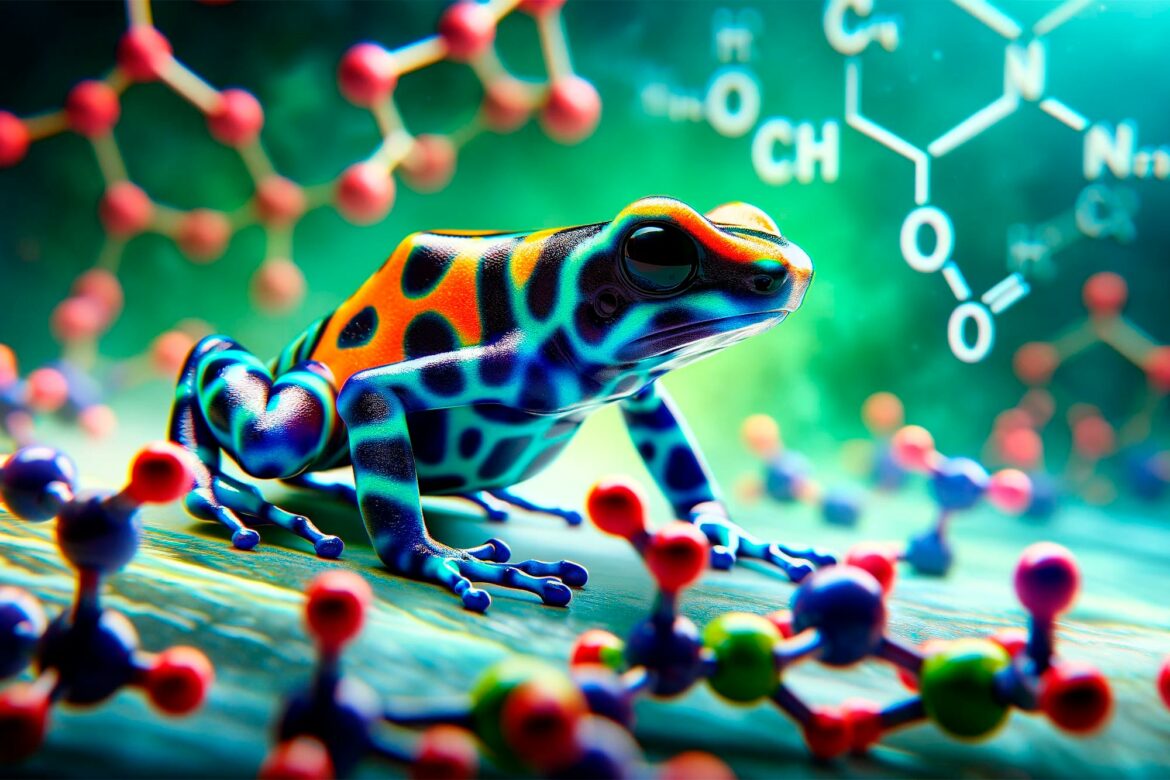In a groundbreaking discovery, scientists have unearthed a crucial protein in poison dart frogs, shedding light on how these remarkable creatures safely store and utilize their deadly alkaloids for self-defense. This revelation holds promise for potential breakthroughs in the treatment of human poisonings caused by similar toxic substances.
Alkaloids: From Pleasure to Poison
Alkaloids, found in everyday indulgences like coffee, tea, and chocolate, contribute to their delightful flavors but can turn harmful in excessive quantities. In humans, the liver efficiently metabolizes these compounds in moderate doses. In stark contrast, tiny poison dart frogs consume copious amounts of highly toxic alkaloids in their diet. Rather than metabolizing these toxins, they employ a unique defense mechanism by accumulating them in their skin, thereby warding off predators.
Aurora Alvarez-Buylla, the lead author and a PhD student in the Biology Department at Stanford University, California, explains, “For years, the mystery has revolved around how poison dart frogs transport highly toxic alkaloids throughout their bodies without succumbing to their venom. We set out to unravel this enigma by searching for proteins capable of binding and safely transporting alkaloids within the frogs’ bloodstream.”
Revealing the Frog’s Hidden Secret
To unveil this secret, Alvarez-Buylla and her team used a compound akin to the poison frog alkaloid as a “molecular fishing hook” to attract and bind proteins found in blood samples taken from the Diablito poison frog. This engineered compound emitted a fluorescent glow under specific light conditions, enabling the researchers to observe the proteins as they bound to this decoy.
Subsequently, the team isolated the proteins to study their interactions with alkaloids in a solution. This investigation unveiled the presence of a protein known as alkaloid binding globulin (ABG), which functions as a remarkable “toxin sponge,” adept at collecting alkaloids. Furthermore, they identified the specific regions of the protein essential for successful alkaloid binding through systematic testing.
Implications for Humans and Future Research
Alvarez-Buylla notes, “The manner in which ABG binds alkaloids exhibits similarities to how proteins in human blood transport hormones to their targets. This revelation hints at the possibility that the frog’s hormone-transporting proteins have evolved to manage alkaloid toxins effectively.”
The authors suggest that the parallels between ABG and human hormone-transporting proteins may serve as a foundation for endeavors to bioengineer human proteins capable of “sponging up” toxins. Senior author Lauren O’Connell, Assistant Professor in the Department of Biology at Stanford University, adds, “Should these efforts prove successful, they could pave the way for innovative approaches to treating specific types of poisonings.”
In addition to its potential medical significance, this discovery offers a molecular comprehension of a fundamental aspect of poison frog biology, which will undoubtedly prove invaluable for future research into the biodiversity and evolution of chemical defense mechanisms in the natural world.
Reference: “Binding and sequestration of poison frog alkaloids by a plasma globulin” by Aurora Alvarez-Buylla, Marie-Therese Fischer, Maria Dolores Moya Garzon, Alexandra E Rangel, Elicio E Tapia, Julia T Tanzo, H Tom Soh, Luis A Coloma, Jonathan Z Long and Lauren A O’Connell, 19 December 2023, eLife.
DOI: doi:10.7554/eLife.85096
Funding: National Science Foundation, New York Stem Cell Foundation, National Science Foundation Graduate Research Fellowship Program, Howard Hughes Medical Institute, Fundación Alfonso Martín Escudero, Wu Tsai Human Performance Alliance.
Table of Contents
Frequently Asked Questions (FAQs) about Alkaloid-binding protein
What is the significance of the discovered protein in poison dart frogs?
The discovered protein, alkaloid binding globulin (ABG), plays a crucial role in allowing poison dart frogs to safely accumulate and store toxic alkaloids in their skin for self-defense against predators.
How do poison dart frogs use alkaloids for self-defense?
Rather than metabolizing the toxic alkaloids they consume in their diet, poison dart frogs accumulate these substances in their skin, using them as a potent defense mechanism against predators.
What are the potential implications for human poisonings?
The discovery of ABG and its similarity to human hormone-transporting proteins suggests the possibility of bioengineering human proteins to “sponge up” toxins. This breakthrough could lead to innovative approaches in treating certain types of poisonings in humans.
Why is this discovery important beyond medical applications?
Understanding the molecular mechanisms of poison frog biology provides valuable insights into the evolution and biodiversity of chemical defense strategies in nature, which can inform future research in various scientific fields.
More about Alkaloid-binding protein
- eLife Article – The original research paper providing in-depth information on the discovery of the alkaloid binding globulin (ABG) and its significance.
- Stanford University Department of Biology – The department’s website for more information on the researchers and their work.
- Wu Tsai Neurosciences Institute – Learn more about the institute’s contributions to this research.
- National Science Foundation – Information about the funding source for this study and its role in supporting scientific research.
- New York Stem Cell Foundation – Details about the foundation’s involvement in funding scientific research and its impact on breakthrough discoveries.
- Howard Hughes Medical Institute – Explore the institute’s contributions to biomedical research and its support for cutting-edge studies.
- Fundación Alfonso Martín Escudero – Learn about the foundation’s role in supporting scientific endeavors and its contributions to this research.
- Wu Tsai Human Performance Alliance – Find more information on the alliance’s work and its collaboration with researchers in various fields.



5 comments
This frog protein discovery, very important, human medicine benefit, poisonings solution, awesome!
So frogs keep poison, not get sick, smart nature! Human use this? Possible? #FascinatingDiscovery
How frogs do it? Alkaloids, skin defense, interesting! Maybe cure poisonings? #NatureIsAmazing
cool frogs storing poison? wow! human help maybe? #ScienceIsCool
Frogs and humans, similar proteins? Future bioengineering, exciting prospects! #ScientificBreakthrough